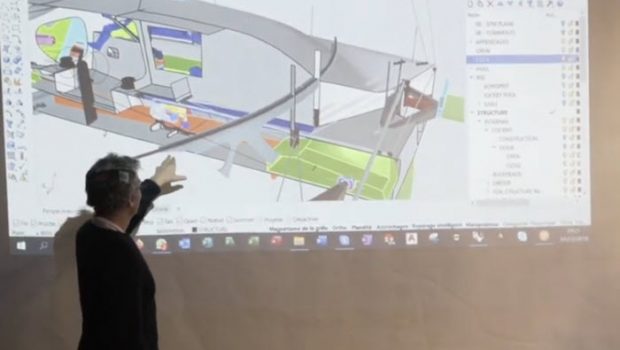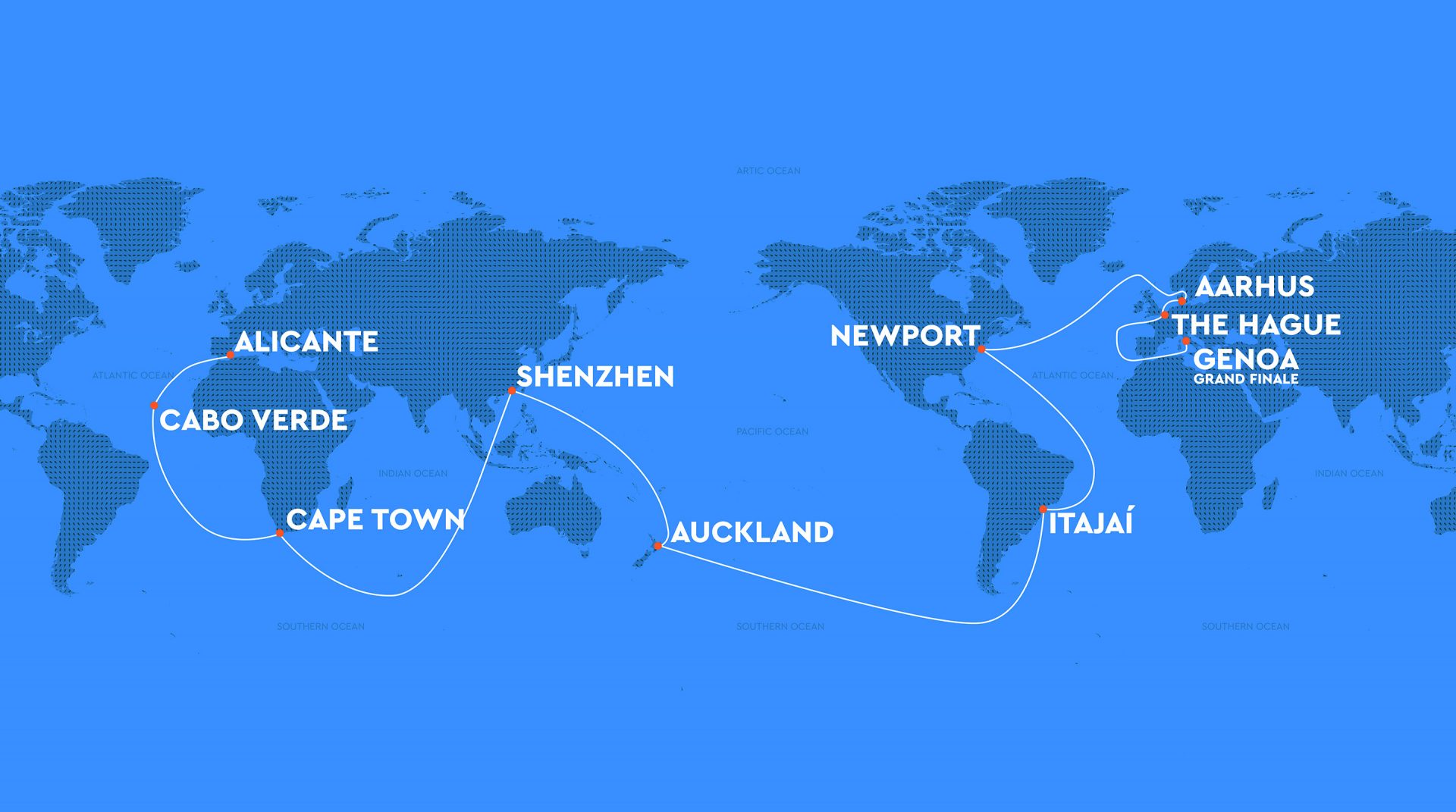On a mission to win The Ocean Race
Published on October 4th, 2020
For the USA-based 11th Hour Racing Team, their ambition to compete in and win The Ocean Race 2022-23 has taken a significant step by revealing the Team is building a brand new IMOCA 60 in Brittany, France.
Led by American skipper Charlie Enright, and Team CEO Mark Towill, who have been a duo in the past two editions (known as the Volvo Ocean Race), they have brought together three of the most experienced and successful offshore racing expert organizations to conceptualize, design, and build the boat.
The new IMOCA 60 is being designed by Guillaume Verdier, one of yacht racing’s most prolific designers with America’s Cup winners, Ultime record-breakers, and was involved in the design of four of the last five Vendée Globe winners.
Verdier brings together the very best minds in the offshore sailing world to work collaboratively across all areas including structural design to routing, engineering to computational fluid dynamics.
11th Hour Racing Team’s strategic partner for the technical and performance aspects of the new boat build is MerConcept, led by offshore racing veteran François Gabart who won the Vendée Globe in 2012.
MerConcept, an Entreprise à Mission [purpose-led company] more recently led the build of Apivia – the latest generation foiling IMOCA, which is a front-runner for the upcoming single-handed round the world race. A group of nearly a dozen engineers, designers and analysts are working on the analytics and data for the performance analysis of the new design.
The boat is being built by CDK Technologies, based out of Lorient and Port-la-Forêt, France, who have constructed many of the leading offshore sailing boats in the sport, including the last three winners of the Vendée Globe and the largest racing trimaran ever built, the Maxi Banque Populaire V.
“When we learned that The Ocean Race was going to be open to a development class we jumped at the opportunity,” commented skipper, Charlie Enright. “We’ve done two laps of the planet now in the one-design Volvo Ocean 65s and are very excited to take this next step in the Race with a custom design and build process.”
Team CEO Towill agreed, “The challenge that we have in front of us now is taking an IMOCA 60 and turning it into a fully crewed Ocean Race boat and integrating sustainability at every step in the process. It’s something that no-one’s ever done before and that to me is the most exciting part of our campaign.”
The Ocean Race co-owner Johan Salen spoke in July 2018 about his vision for teams to embrace the design challenge. “By opening the next race to the IMOCA 60 and the VO65, we intend to attract the very best sailors, designers and teams in the world to take up the challenge of competing in the pinnacle fully-crewed around the world race.
“The introduction of the IMOCA 60 brings a design and engineering element to the race that keeps us at the cutting edge of technology and performance and will be appealing to the most competitive performers in our sport.”
The boat is being built to fit The Ocean Race’s unique racecourse with up to 10 stopovers (including two additional equator crossings with a leg to Asia), which includes more upwind and tight-reaching sailing angles. Additionally, it was designed to meet the strict rules incorporating a crew of five (four male, one female) and one Onboard Reporter (OBR), and a heading-only autopilot.
The new 11th Hour Racing Team IMOCA 60 will be the first of its kind in the Class.
“IMOCA 60s are typically built for single-handed racing therefore teams are allowed a smart autopilot which uses additional boat data, including wind angle and heel of the boat, to help keep the solo sailors on track,” explained Enright. “These boats are built with a tiller-system and sailors hand-steer less than 5% of the time, and are reliant on the autopilot for the rest.
“Whereas in The Ocean Race we are restricted to a heading-only autopilot which is not as accurate so it’s more effective to hand-steer our boat 100% of the time. As a result we have had to design our boat with twin steering wheels. A lot of thought and time went into the cockpit and deck design to ensure that our those driving have line-of-sight to the front of the boat and can see the sails, the wind conditions and sea state.
“This is all part of the exciting design challenge that entry into The Ocean Race 2022-23 has brought us. It keeps the Race true to its DNA which is sailors helming the boats around the world,” he concluded.
The Team started the new design process in June 2019 and are now at the stage of having a completed hull with the deck structure currently underway at CDK Technologies.
Armand de Jacquelot, Project Engineer at MerConcept commented, “One of the interesting challenges for us was to merge the two cultures: the single-handed French one with The Ocean Race. The 11th Hour Racing Team boat will be the first IMOCA 60 of this generation; that’s an exciting situation but also brings a lot of questions.
“We have spent maybe three times the normal time working on the answer to some of these questions like the cockpit configuration. We built a full-scale mock up in the yard so the Team could come and ‘play’ inside the boat. We’ve changed it three times and pivoted from one concept to another. It’s been quite a tough job to achieve the answers and to find a solution for this cockpit, the livability and the requirement to be driving nearly all the time, but I believe we have done it successfully.”
Over the course of the build, 11th Hour Racing’s sustainability team, including a team member on-site in France, is measuring and evaluating the environmental impact of the entire build process, while also researching alternative materials and techniques including the use of flax in low weight-bearing structures in the boat. This is part of the Team’s overall ambition to leave a positive impact on the environment at the end of the campaign.
The Team’s sustainability learnings, driven by Damian Foxall and Amy Munro, will identify key impact hotspots through life cycle assessment. The team are working with the IMOCA Class to develop and set sustainability standards for future builds and will be publishing and sharing resources with the maritime industry and sailing community to encourage the implementation of sustainability plans.
Sustainability Manager Foxall commented, “From the outset as a Team we decided we wanted to have a neutral impact on the environment, but doing less bad is not good enough. We want to make all our areas of operation and influence net positive and regenerative.”
The boat build announcement is the latest news from the Newport, Rhode Island-based Team, which boosted its crew lineup two weeks ago. “We recently announced three new crew members, Simon Fisher, Kyle Langford and Rob Greenhalgh, and will be trialing further crew members to join 11th Hour Racing Team.
“Thankfully we have a very supportive partner in 11th Hour Racing who has allowed us to stick to the original plan and vision, supporting an extra year’s worth of testing, trials, training and racing in the build-up to The Ocean Race 2022-23. It’s going to be an incredible journey,” concluded Towill.
Team details: https://11thhourracingteam.org/
Source: 11th Hour Racing Team
Event details – Route – Teams – Facebook
Here was the plan prior to the 2022-23 postponement:
The Ocean Race 2021-22 (formerly The Volvo Ocean Race) will be raced in two classes of boats: the high-performance, foiling, IMOCA 60 class and the one-design VO65 class which has been used for the last two editions of the race. Entries in the IMOCA 60 class will compete for The Ocean Race trophy, while those racing the VO65s will chase the Ocean Challenge Trophy.
Ten Stopovers for 14th Edition:
• Alicante, Spain: This historic Mediterranean port will host the start for the fifth consecutive edition in the autumn of 2021.
• Cabo Verde: More accustomed to having offshore teams sail by, or stop for repair, this archipelago of ten volcanic islands in the central Atlantic Ocean will become just the second African venue the race has ever visited and the first West African nation to host the event. Details.
• Cape Town, South Africa: Located on the shore of Table Bay, Cape Town, as the oldest urban area in South Africa, was developed by the United East India Company (VOC) as a supply station for Dutch ships sailing to East Africa, India, and the Far East. Located at latitude 33.55° S, it’s approximately the same as Sydney and Buenos Aires and equivalent to Casablanca and Los Angeles in the northern hemisphere. Details.
• Shenzhen, China: Located in the southeast, the city is a modern metropolis that links Hong Kong to China’s mainland. It’s known for its shopping destinations and features contemporary buildings, such as the 600m-tall skyscraper Ping An International Finance Centre, and a number of amusement parks. The city is a leading global technology hub and was one of the fastest-growing cities in the world in the 1990s and the 2000s. Details.
• Auckland, New Zealand: European, Polynesian, Asian, and strong Maori heritages give Auckland its distinctive culture. Located in the North Island of New Zealand, it is the most populous urban area in the country with an urban population of around 1,570,100. Details.
• Itajaí, Brazil: To the south of Rio de Janeiro, Itajaí was founded in the mid-19th century by German and Italian colonists, and is now the commercial centre and Atlantic port for an agricultural region drained by the Itajaí River and its tributaries. Details.
• Newport, USA: Located on Aquidneck Island, Newport is 74 miles south of Boston and 180 miles northeast of New York City. It is known as a New England summer resort and is famous for its historic mansions and its rich sailing history. It was the location of every challenge to the America’s Cup between 1930 and 1983. It is also the home of Naval Station Newport, which houses the United States Naval War College, the Naval Undersea Warfare Center, and an important Navy training center. This is the third consecutive edition of the race to stop in Newport. Details.
• Aarhus, Denmark: The course comes to the east coast of the Jutland peninsula during the spring of 2022, following a popular ‘Fly-By’ of the city during the final leg of the 2017-18 edition of the Race. Details.
• The Hague, Netherlands: This city along the North Sea coast will welcome the race for a third consecutive time, first coming as a ‘pitstop’ on the final leg of the 2014-15 edition and as the final finish port for the 2017-18 race. Details.
• Genoa, Italy: As the birthplace of Christopher Columbus, this first-time race host is Italy’s largest sea port yet remains full of grandeur as the gateway to the Riviera while offering weighty architectural heritage. Details.










 We’ll keep your information safe.
We’ll keep your information safe.